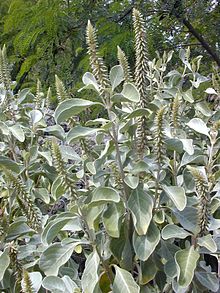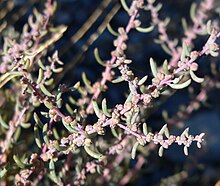ผลต่างระหว่างรุ่นของ "วงศ์บานไม่รู้โรย"
Rescuing 1 sources and tagging 0 as dead.) #IABot (v2.0.8.6 |
คำอธิบาย |
||
| บรรทัด 27: | บรรทัด 27: | ||
'''วงศ์บานไม่รู้โรย''' หรือ ([[:en:Amaranthaceae]]) เป็นวงศ์ของพืชมีดอกขนาดใหญ่ในอันดับ [[Caryophyllales]] ปัจจุบันได้นำพืชจากวงศ์ ([[:en:Chenopodiaceae]]) มารวมด้วย ทำให้มี 180 สกุลและ 2,500 สปีชีส์ |
'''วงศ์บานไม่รู้โรย''' หรือ ([[:en:Amaranthaceae]]) เป็นวงศ์ของพืชมีดอกขนาดใหญ่ในอันดับ [[Caryophyllales]] ปัจจุบันได้นำพืชจากวงศ์ ([[:en:Chenopodiaceae]]) มารวมด้วย ทำให้มี 180 สกุลและ 2,500 สปีชีส์ |
||
== คำอธิบาย == |
|||
ตระกูลผักโขมส่วนใหญ่เป็นสมุนไพรหรือไม้พุ่มย่อยประจำปีหรือยืนต้น บ้างก็เป็นพุ่มไม้ มีเพียงไม่กี่สายพันธุ์ที่เป็นเถาวัลย์หรือต้นไม้<ref>{{cite web|title=Amaranthaceae|url=https://link.springer.com/chapter/10.1007/978-94-024-1157-7_24|accessdate=2024-01-29|publisher=link.springer.com}}</ref><ref>{{cite web|title=Is Amaranth A Perennial? With The Clearest Explanation|url=https://www.smallspacegardeningbasics.com/is-amaranth-a-perennial/|accessdate=2024-01-29|publisher=www.smallspacegardeningbasics.com}}</ref><ref>{{cite web|title=Amaranth Family (Amaranthaceae)|url=https://www.botanicohub.com/plant-families/amaranthaceae|accessdate=2024-01-29|publisher=www.botanicohub.com}}</ref> บางประเภทก็ฉ่ำ หลายชนิดมีลำต้นที่มีโหนดหนา ไม้ของลำต้นยืนต้นมีการเจริญเติบโตรองที่ "ผิดปกติ" โดยทั่วไป เฉพาะในวงศ์ย่อย Polycnemoideae เท่านั้นที่มีการเจริญเติบโตรองตามปกติ<ref>{{cite web|title=Amaranthaceae|url=https://memim.com/amaranthaceae.html|accessdate=2024-01-29|publisher=memim.com}}</ref> |
|||
ใบมีลักษณะเรียบง่าย มักเรียงสลับ บางครั้งก็ตรงกันข้าม พวกเขาไม่เคยมีข้อกำหนด พวกมันแบนหรือเทเรต์ และรูปร่างของมันแปรผันอย่างมาก โดยมีขอบแข็งหรือหยัก ในบางสายพันธุ์ใบจะเล็กลงจนเหลือเกล็ดเล็กๆ ในกรณีส่วนใหญ่ จะไม่เกิดการรวมกลุ่มกันเป็นกระจุกที่ฐานหรือปลายใบ<ref>{{cite web|title=The family Amaranthaceae|url=http://www.mobot.org/MOBOT/Research/APweb/orders/caryophyllalesweb.htm#Amaranthaceae|accessdate=2024-01-29|publisher=www.mobot.org}}</ref> |
|||
== ความสำคัญทางเศรษฐกิจ == |
|||
บางชนิด เช่น ผักโขม (Spinacia oleracea) หรือพันธุ์บีทรูท (Beta vulgaris) (หัวบีท, chard) ใช้เป็นผัก<ref>{{cite web|title=Beta vulgaris subsp. maritima|url=https://efloraofindia.com/2011/04/21/beta-vulgaris-subsp-maritima/|accessdate=2024-01-29|publisher=efloraofindia.com}}</ref> รูปแบบของ Beta vulgaris ได้แก่ หัวบีทอาหารสัตว์ (Mangelwürzel) และหัวบีทชูการ์ เมล็ดผักโขม เนื้อแกะ (Chenopodium berlandieri), quinoa (Chenopodium quinoa) และ canyweed (Chenopodium pallidicaule) สามารถรับประทานได้และใช้เป็นไขมันเทียม เมล็ดผักโขมอุดมไปด้วยโปรตีนและไฟเบอร์<ref>{{cite web|title=The Role of a Dietitian in Promoting Amaranth as a High-Protein Whole Grain|url=https://heyfitnessclub.com/dietitian-amaranth-high-protein-whole-grain/|accessdate=2024-01-29|publisher=heyfitnessclub.com}}</ref> |
|||
หลายชนิดเป็นไม้ประดับสวนยอดนิยม โดยเฉพาะพันธุ์จากจำพวก Alternanthera, Amaranthus, Celosia และ Iresine สายพันธุ์อื่นๆ ถือเป็นวัชพืช เช่น โรสแมรี่ป่า (Amaranthus retroflexus) และหญ้าจระเข้ (Alternanthera philoxeroides) และบางชนิดเป็นสายพันธุ์รุกรานที่เป็นปัญหา โดยเฉพาะในอเมริกาเหนือ รวมถึง Kali tragus และ Bassia scoparia เป็นที่รู้กันว่าหลายชนิดทำให้เกิดอาการแพ้ละอองเกสรดอกไม้<ref>{{cite web|title=List of allergic plants in family Chenopodiaceae|url=https://www.pollenlibrary.com/FAMILY/CHENOPODIACEAE/|accessdate=2024-01-29|publisher=www.pollenlibrary.com}}</ref> |
|||
== สกุล == |
== สกุล == |
||
| บรรทัด 67: | บรรทัด 77: | ||
* [http://www.ars-grin.gov/cgi-bin/npgs/html/gnlist.pl?48 Genera of ''Amaranthaceae''] {{Webarchive|url=https://web.archive.org/web/20041118053822/http://www.ars-grin.gov/cgi-bin/npgs/html/gnlist.pl?48 |date=2004-11-18 }} at [[Germplasm Resources Information Network|Germplasm Resources Information Network (USDA)]] |
* [http://www.ars-grin.gov/cgi-bin/npgs/html/gnlist.pl?48 Genera of ''Amaranthaceae''] {{Webarchive|url=https://web.archive.org/web/20041118053822/http://www.ars-grin.gov/cgi-bin/npgs/html/gnlist.pl?48 |date=2004-11-18 }} at [[Germplasm Resources Information Network|Germplasm Resources Information Network (USDA)]] |
||
* [http://www.mobot.org/MOBOT/Research/APweb/orders/caryophyllalesweb.htm#Amaranthaceae The Amaranthaceae family] at [http://www.mobot.org/MOBOT/Research/APweb/welcome.html APWebsite.] (chapters description, photosynthesis pathway, phytochemistry) |
* [http://www.mobot.org/MOBOT/Research/APweb/orders/caryophyllalesweb.htm#Amaranthaceae The Amaranthaceae family] at [http://www.mobot.org/MOBOT/Research/APweb/welcome.html APWebsite.] (chapters description, photosynthesis pathway, phytochemistry) |
||
== อ้างอิง == |
|||
{{reflist}} |
|||
[[หมวดหมู่:วงศ์บานไม่รู้โรย]] |
[[หมวดหมู่:วงศ์บานไม่รู้โรย]] |
||
รุ่นแก้ไขปัจจุบันเมื่อ 02:09, 29 มกราคม 2567
ลิงก์ข้ามภาษาในบทความนี้ มีไว้ให้ผู้อ่านและผู้ร่วมแก้ไขบทความศึกษาเพิ่มเติมโดยสะดวก เนื่องจากวิกิพีเดียภาษาไทยยังไม่มีบทความดังกล่าว กระนั้น ควรรีบสร้างเป็นบทความโดยเร็วที่สุด |
| วงศ์บานไม่รู้โรย | |
|---|---|

| |
| Amaranthus retroflexus | |
| การจำแนกชั้นทางวิทยาศาสตร์ | |
| อาณาจักร: | Plantae |
| ไม่ได้จัดลำดับ: | Angiosperms |
| ไม่ได้จัดลำดับ: | Eudicots |
| ไม่ได้จัดลำดับ: | Core eudicots |
| อันดับ: | Caryophyllales |
| วงศ์: | Amaranthaceae Juss. |
| สกุลต้นแบบ | |
| Amaranthus L. | |
| วงศ์ย่อย | |
|
Amaranthoideae | |
วงศ์บานไม่รู้โรย หรือ (en:Amaranthaceae) เป็นวงศ์ของพืชมีดอกขนาดใหญ่ในอันดับ Caryophyllales ปัจจุบันได้นำพืชจากวงศ์ (en:Chenopodiaceae) มารวมด้วย ทำให้มี 180 สกุลและ 2,500 สปีชีส์
คำอธิบาย[แก้]
ตระกูลผักโขมส่วนใหญ่เป็นสมุนไพรหรือไม้พุ่มย่อยประจำปีหรือยืนต้น บ้างก็เป็นพุ่มไม้ มีเพียงไม่กี่สายพันธุ์ที่เป็นเถาวัลย์หรือต้นไม้[1][2][3] บางประเภทก็ฉ่ำ หลายชนิดมีลำต้นที่มีโหนดหนา ไม้ของลำต้นยืนต้นมีการเจริญเติบโตรองที่ "ผิดปกติ" โดยทั่วไป เฉพาะในวงศ์ย่อย Polycnemoideae เท่านั้นที่มีการเจริญเติบโตรองตามปกติ[4]
ใบมีลักษณะเรียบง่าย มักเรียงสลับ บางครั้งก็ตรงกันข้าม พวกเขาไม่เคยมีข้อกำหนด พวกมันแบนหรือเทเรต์ และรูปร่างของมันแปรผันอย่างมาก โดยมีขอบแข็งหรือหยัก ในบางสายพันธุ์ใบจะเล็กลงจนเหลือเกล็ดเล็กๆ ในกรณีส่วนใหญ่ จะไม่เกิดการรวมกลุ่มกันเป็นกระจุกที่ฐานหรือปลายใบ[5]
ความสำคัญทางเศรษฐกิจ[แก้]
บางชนิด เช่น ผักโขม (Spinacia oleracea) หรือพันธุ์บีทรูท (Beta vulgaris) (หัวบีท, chard) ใช้เป็นผัก[6] รูปแบบของ Beta vulgaris ได้แก่ หัวบีทอาหารสัตว์ (Mangelwürzel) และหัวบีทชูการ์ เมล็ดผักโขม เนื้อแกะ (Chenopodium berlandieri), quinoa (Chenopodium quinoa) และ canyweed (Chenopodium pallidicaule) สามารถรับประทานได้และใช้เป็นไขมันเทียม เมล็ดผักโขมอุดมไปด้วยโปรตีนและไฟเบอร์[7]
หลายชนิดเป็นไม้ประดับสวนยอดนิยม โดยเฉพาะพันธุ์จากจำพวก Alternanthera, Amaranthus, Celosia และ Iresine สายพันธุ์อื่นๆ ถือเป็นวัชพืช เช่น โรสแมรี่ป่า (Amaranthus retroflexus) และหญ้าจระเข้ (Alternanthera philoxeroides) และบางชนิดเป็นสายพันธุ์รุกรานที่เป็นปัญหา โดยเฉพาะในอเมริกาเหนือ รวมถึง Kali tragus และ Bassia scoparia เป็นที่รู้กันว่าหลายชนิดทำให้เกิดอาการแพ้ละอองเกสรดอกไม้[8]
สกุล[แก้]







แหล่งข้อมูลอื่น[แก้]
- Genera of Amaranthaceae เก็บถาวร 2004-11-18 ที่ เวย์แบ็กแมชชีน at Germplasm Resources Information Network (USDA)
- The Amaranthaceae family at APWebsite. (chapters description, photosynthesis pathway, phytochemistry)
อ้างอิง[แก้]
- ↑ "Amaranthaceae". link.springer.com. สืบค้นเมื่อ 2024-01-29.
- ↑ "Is Amaranth A Perennial? With The Clearest Explanation". www.smallspacegardeningbasics.com. สืบค้นเมื่อ 2024-01-29.
- ↑ "Amaranth Family (Amaranthaceae)". www.botanicohub.com. สืบค้นเมื่อ 2024-01-29.
- ↑ "Amaranthaceae". memim.com. สืบค้นเมื่อ 2024-01-29.
- ↑ "The family Amaranthaceae". www.mobot.org. สืบค้นเมื่อ 2024-01-29.
- ↑ "Beta vulgaris subsp. maritima". efloraofindia.com. สืบค้นเมื่อ 2024-01-29.
- ↑ "The Role of a Dietitian in Promoting Amaranth as a High-Protein Whole Grain". heyfitnessclub.com. สืบค้นเมื่อ 2024-01-29.
- ↑ "List of allergic plants in family Chenopodiaceae". www.pollenlibrary.com. สืบค้นเมื่อ 2024-01-29.
